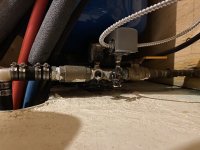hottubbrad
New Member
Our line from our well to the house (well with submersible pump at 120 feet deep) froze when we were away for a month in the winter. Unfortunately, we are on bedrock and the pipe is only 3 feet deep.
I drove hot water down the 1" line using a length of 1/2" Pex. I fed the 1/2" little by little as the frozen area thawed. After 8 hours of fun, the frozen area was thawed and the water was back on.
Once spring came, we began noticing air from our faucets. You can also hear air bubbling in the water softener and pressure tank a little bit. We get small, occasional burps from some of the house faucets. We get large burps from the outside faucet that does not go through the softener. We also have 2 stage filtration with 10 micron pleated and 1 micron carbon block (big blue filters). I have not noticed any extra sediment on the filters.
My question is: Could a cracked poly pipe or fitting cause that much air to come into the system. I understand with a self priming pump it could, but what about a submersible? Where else can I look for the issue?
I am going to dig it up anyway to add heat trace but I would love to narrow it down somewhat ...
Thanks for your help.
I drove hot water down the 1" line using a length of 1/2" Pex. I fed the 1/2" little by little as the frozen area thawed. After 8 hours of fun, the frozen area was thawed and the water was back on.
Once spring came, we began noticing air from our faucets. You can also hear air bubbling in the water softener and pressure tank a little bit. We get small, occasional burps from some of the house faucets. We get large burps from the outside faucet that does not go through the softener. We also have 2 stage filtration with 10 micron pleated and 1 micron carbon block (big blue filters). I have not noticed any extra sediment on the filters.
My question is: Could a cracked poly pipe or fitting cause that much air to come into the system. I understand with a self priming pump it could, but what about a submersible? Where else can I look for the issue?
I am going to dig it up anyway to add heat trace but I would love to narrow it down somewhat ...
Thanks for your help.

